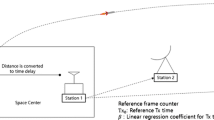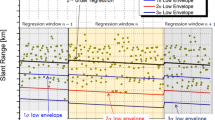Abstract
In general, a ground telemetry station for a launch vehicle (LV) includes a tracking function only; therefore, position measurements for LV depend on received navigation data from on-board systems of LV or depend on estimated position from ground radar system in real time. At the first launch of the Korea Space Launch Vehicle-1 (KSLV-1) in August 2009, we observed anomalies in ‘pairing separation’ event. As a result, we failed to obtain stable navigation data of the LV. In addition, estimated positions from the radar station away 1000 km to the LV also included many errors due to low antenna elevation angle. The experiences of failure has led to needs for additional localization solutions in ship-born telemetry station deployed in the Pacific to cover ‘satellite separation’ event. Time of arrival (TOA), time difference of arrival (TDOA), and angle of arrival (AOA) are typical location techniques used for an emitting target. In this study, we analyze three localization methods: TOA–AOA, AOA–AOA, and TDOA–AOA for a LV using ground telemetry stations. When each ground station is synchronized to a GPS time, by comparing the time stamps of each receiver (Rx), TOA and TDOA equations can be obtained. In addition, AOA equations can be obtained from the monopulse tracking antenna of each station. By solving these equations, a three-dimensional (3D) target point can be obtained. We confirm localization performance of the proposed solution by comparing with an on-board GPS of 3rd KSLV-1 mission in January 2013.















Similar content being viewed by others
References
Parkinson, B. B. W., Spilker, J. J., Axelrad, P., & Enge, P. (2010). Global positioning system: Theory and applications. In Progress in astronautics and aeronautics (Vol. 2). American Institute of Aeronautics and Astronautics.
Chen, L., Julien, O., Thevenon, P., Serant, D., Peña, A. G., & Kuusniemi, H. (2015). TOA estimation for positioning with DVB-T signals in outdoor static tests. IEEE Transactions on Broadcasting, 61(4).
Tao, J., & Buehrer, R. M. (2008). A new Cramer-Rao lower bound for TOA based localization. In 2008 Military communications conference (pp. 1–5).
Bialer, O., Raphaeli, D., & Weiss, A. J. (2012). Efficient time of arrival estimation algorithm achieving maximum likelihood performance in dense multipath. IEEE Transactions on Signal Processing, 60(3), 1241–1252.
Khan, M. W., Salman, N., & Kemp, A. H. (2014). Enhanced hybrid positioning in wireless networks I: AoA–ToA. In 2014 International conference on telecommunications and multimedia (TEMU), IEEE (pp. 86–91).
Jeong, S., Sung, T.-K., Lee, K. E., & Kang, J. (2014). Joint TOA/AOA-based localization in wireless sensor networks. In 2014 IEEE 8th international conference on signal processing and communication systems (ICSPCS).
Sun, Y., Zhou, Z., Tang, S., Ding, X. K., Yin, J., & Wan, Q. (2016). 3D hybrid TOA–AOA source localization using an active and a passive station. In 2016 IEEE 13th International Conference on Signal Processing (ICSP).
Rong, P., & Sichitiu, M. L. (2006). Angle of arrival localization for wireless sensor networks. In Sensor and ad hoc communications and networks 2006. IEEE.
Chan, Y. T., & Ho, K. C. (1994). A simple and efficient estimator for hyperbolic location. IEEE Transactions on Signal Processing, 42(8), 1905–1915.
Ma, C., Klukas, R., & Lachapelle, G. (2003). An enhanced two-step least squared approach for TDOA/AOA wireless location. In Proceedings of IEEE international conference (Vol. 2, pp. 987–991).
Acknowledgements
This research was supported by the Space Center Development Project (II) and the ITRC (Information Technology Research Center) support program (IITP-2016-R2718-16-0011) supervised by the IITP (Institute for Information & communications Technology Promotion) of the MSIP (Ministry of Science, ICT and Future Planning), Korea. This research was supported by Basic Science Research Program through the National Research Foundation of Korea (NRF) funded by the Ministry of Education (NRF-2015R1D1A1A01059397). This study was financially supported by Korea Aerospace Research Institute (KARI) and Chonnam National University (Grant Number: 2016-2503).
Author information
Authors and Affiliations
Corresponding author
Additional information
Publisher's Note
Springer Nature remains neutral with regard to jurisdictional claims in published maps and institutional affiliations.
Rights and permissions
About this article
Cite this article
Kwon, S., Kim, D., Lee, J. et al. Performance Analysis of 3D Localization for a Launch Vehicle Using TOA, AOA, and TDOA. Wireless Pers Commun 103, 1443–1464 (2018). https://doi.org/10.1007/s11277-018-5862-7
Published:
Issue Date:
DOI: https://doi.org/10.1007/s11277-018-5862-7




